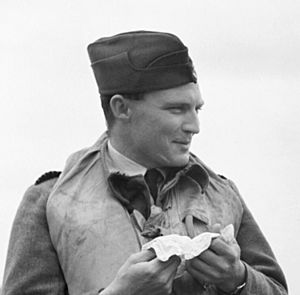Petrus Hugo facts for kids
Quick facts for kids
Petrus Hendrik Hugo
|
|
|---|---|

Petrus Hugo c.1940s
|
|
| Nickname(s) | "Dutch" |
| Born | 20 December 1917 Pampoenpoort, Victoria West, Union of South Africa |
| Died | 6 June 1986 (aged 68) Victoria West, Cape, South Africa |
| Buried |
On family farm near Victoria West
|
| Allegiance | United Kingdom |
| Service/ |
Royal Air Force |
| Years of service | 1939–1950 |
| Rank | Group Captain |
| Service number | 41848 |
| Commands held | No. 322 Wing RAF (1942–44) No. 41 Squadron RAF (1941–42) |
| Battles/wars | Second World War |
| Awards | Distinguished Service Order Distinguished Flying Cross & Two Bars Distinguished Flying Cross (United States) Croix de guerre (France) |
Petrus Hendrik Hugo (born December 20, 1917 – died June 6, 1986) was a brave South African fighter pilot. He became a "flying ace" in the Royal Air Force (RAF) during the Second World War. A flying ace is a pilot who has shot down five or more enemy aircraft. He was known for his courage and skill in the air.
Contents
Early Life and Training
Petrus Hendrik Hugo was born on December 20, 1917, on a farm called Pampoenpoort in South Africa. He studied aeronautical engineering, which is about designing and building aircraft. In 1938, he traveled to the United Kingdom to learn how to fly at a civilian flying school.
Joining the Royal Air Force
On April 1, 1939, Petrus joined the Royal Air Force (RAF). Because he was from South Africa and had a strong accent, his friends quickly gave him the nickname "Dutch." He was known by this name throughout his time in the RAF.
He trained at a special flying school for six months and was considered an "exceptional" student. After that, he went to a fighter pilot school in Wales. In December 1939, he joined No. 615 Squadron RAF in France. At first, they flew Gloster Gladiator planes.
World War II Hero
In April 1940, his squadron received new, faster planes called Hawker Hurricanes. These planes were very important for fighting in the war.
Fighting in France and Britain
During the Battle of France, Petrus Hugo showed his bravery. On May 20, 1940, he successfully shot down an enemy bomber. After this battle, his squadron moved back to the United Kingdom.
He continued to fight bravely during the Battle of Britain, which was a huge air battle over England. On July 20, 1940, he shot down two enemy fighter planes. He shot down another one five days later. He even helped shoot down a large enemy seaplane.
On August 16, he was hit by enemy fire and slightly wounded in his legs. But he was back in action just two days later! However, he was attacked again by enemy planes and was wounded in his leg, eye, and face. He managed to crash-land his plane safely and was taken to the hospital.
For his amazing courage and for shooting down five enemy aircraft, Petrus was awarded the Distinguished Flying Cross (DFC) on August 23, 1940. This is a very important medal given for bravery in air operations.
Leading a Squadron
In mid-1941, his squadron received even more powerful Hurricane planes. Petrus continued to fly and fight. On October 21, 1941, he was promoted to Flight Lieutenant.
Soon after, on November 20, he was given command of No. 41 Squadron RAF, which flew the famous Supermarine Spitfire planes. For his continued bravery, he received a "Bar" to his DFC on November 25. A Bar means he received the DFC medal again for more acts of bravery.
In February 1942, he shot down another enemy plane during a big naval event. He continued to achieve victories, shooting down more enemy planes over France. He was promoted to Wing Commander on April 12, a higher leadership role.
However, on April 27, he was wounded again and had to bail out of his plane over the English Channel. He was rescued from the water. While recovering, he was awarded the Distinguished Service Order (DSO), an even higher award for outstanding leadership and bravery in combat.
Operations in North Africa
In late November 1942, Petrus took command of No. 322 Wing RAF in North Africa. He continued his incredible record, shooting down many more enemy planes, including bombers and fighters. He was known for his aggressive flying and leadership.
On February 16, 1943, he received a second Bar to his DFC for his success in North Africa. This meant he had earned the DFC three times!
He returned to lead No. 322 Wing in June 1943 and continued to achieve victories. His last confirmed victory of the war was on November 18, 1943, when he shot down an enemy seaplane over the Adriatic Sea.
By the end of the war, Petrus Hendrik Hugo had officially shot down 17 enemy aircraft, shared in the destruction of three others, and probably destroyed three more. He also damaged seven enemy planes. This made him one of the most successful fighter pilots of the war.
Post-War Career
After the Second World War ended, Petrus Hugo remained in the RAF. He continued his training and service. He retired from the RAF in February 1950 and was allowed to keep the high rank of Group Captain.
Later Life and Legacy
Petrus Hugo passed away in 1986. His medals, which showed his amazing bravery and service, were later sold at an auction for a large sum of money. A place called Hugo Gardens in London is named after him, honoring his contributions during the war.

